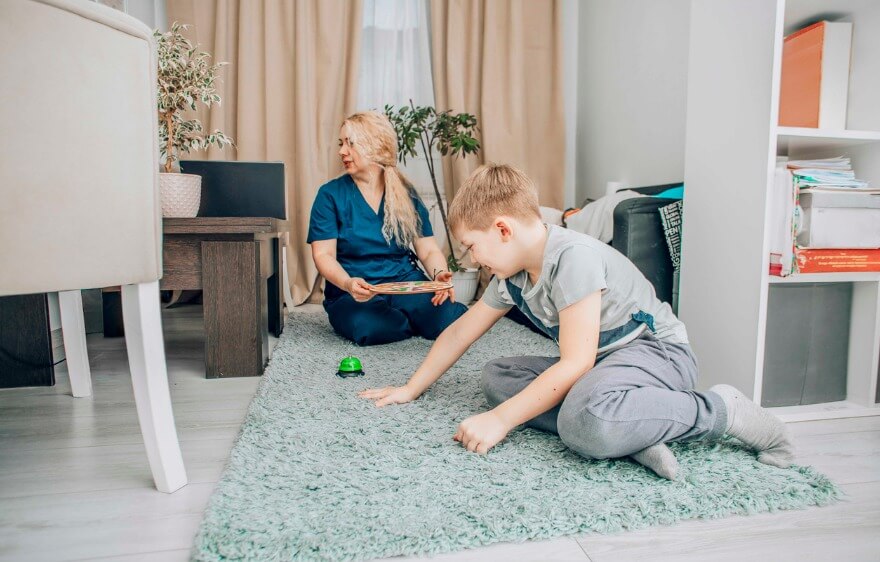Occupational therapy gets expressive when you add in some creative arts! In this blog post, we’ll explore the enriching world of pediatric occupational therapy (OT) through many expressive activities such as painting, drawing, and crafting. These endeavors engage kids in enjoyable and imaginative experiences and enhance their motor skills, cognitive abilities, and overall development.
The Importance of Expressive Activities in Pediatric OT
Developing Fine Motor Skills
Artistic activities like painting, drawing, and crafting require kids to use fine motor skills. The precise movements involved in holding a paintbrush, manipulating craft materials, or drawing with crayons contribute to developing and refining hand-eye coordination and manual dexterity.
Enhancing Cognitive Abilities
Expressive activities tend to stimulate cognitive functions like problem-solving, planning, and spatial awareness. When kids engage in creative projects, they must make decisions about color choices, shapes, and the arrangement of elements in their artwork, fostering cognitive development in an enjoyable and non-intrusive manner.
Fostering Emotional Expression
Artistic endeavors provide a platform for kids to express themselves emotionally. Whether through their choice of colors, the subject matter of their drawings, or the stories behind their crafts, kiddos can communicate and process emotions in a therapeutic and creative way. This is particularly valuable for those who may struggle to articulate their feelings verbally.
Expressive Activities in Pediatric OT
Painting Therapy
- Finger Painting for Sensory Exploration: Finger painting is an excellent activity for sensory exploration. The tactile experience of manipulating paint with fingers promotes sensory integration, helping kids understand and tolerate different textures.
- Brush Painting for Fine Motor Skills: Using paintbrushes encourages refining fine motor skills. Let them practice different brush strokes, experiment with various pressure levels, and enhance hand control while creating visually stimulating artwork.
Drawing and Sketching
- Pencil Grasp and Control: Drawing with pencils or crayons targets specific hand muscles essential for a kid’s fine motor development. Pediatric OTs may guide kids in practicing different pencil grasps and strokes, promoting precision and control in their drawing activities.
- Visual Perception Exercises: Drawing activities also contribute to visual perception development. You can enhance their visual-motor integration, spatial awareness, and overall visual processing abilities by connecting dots, tracing lines, or copying shapes.
Crafting Adventures:
- Scissor Skills: Engaging in crafts often involves cutting paper or other materials. This activity enhances scissor skills, promoting bilateral coordination and hand strength. Cutting along lines or creating intricate shapes allows for a gradual progression in difficulty tailored to each child’s skill level.
- 3D Construction for Spatial Awareness: Crafting three-dimensional structures with materials like paper, clay, or recycled items improves spatial awareness development. Kids can learn to manipulate objects in space, understand proportions, and enhance their spatial reasoning.
Therapeutic Approaches
Sensory Integration Techniques
Pediatric OTs often use expressive activities as part of sensory integration techniques. By incorporating diverse textures, colors, and materials, the kiddos can engage their senses in a controlled and therapeutic environment, promoting sensory modulation and self-regulation.
Social Interaction and Communication
Group crafting sessions provide opportunities for social interaction and communication. Let them learn to collaborate, share ideas, and express themselves verbally while working on joint projects. These experiences contribute to the development of essential social skills.
Tailoring Activities to Individual Needs
Individualized Goals and Modifications
One of the strengths of using expressive activities in pediatric OT lies in its adaptability to individual needs. Occupational therapists carefully assess their abilities, challenges, and developmental goals, tailoring activities to address specific areas of concern or promote particular skills.
Adaptive Equipment and Techniques
For those with physical challenges or disabilities, adaptive equipment and techniques can be incorporated into expressive activities. This ensures that every child can actively participate and benefit from the therapeutic aspects of painting, drawing, and crafting, regardless of their abilities.
Parent Involvement and Home Activities
Extension to Home Environment
Pediatric OTs often collaborate with parents to extend therapeutic activities into the home environment. Simple and accessible activities, such as providing drawing materials or engaging in family crafting projects, can reinforce the progress made during therapy sessions.
Encouraging Creativity Beyond Therapy
Expressive activities extend beyond therapy sessions, encouraging kids to explore their creativity independently. Providing a supportive environment at home where artistic expression is celebrated contributes to ongoing developmental benefits.
Incorporating expressive activities like painting, drawing, and crafting into pediatric occupational therapy makes the process enjoyable for kids and a powerful tool for holistic development. As your kiddos engage in these creative endeavors, they refine their motor skills and cognitive abilities, express emotions, foster social interaction, and build a foundation for lifelong creative exploration. With the guidance of skilled pediatric OTs, these activities become more than just play — they become a pathway to unlocking the full potential of each child’s unique abilities.
Join the Care Options For Kids Team!
Are you ready for meaningful work that comes with benefits and not burnout? Join the compassionate care team that helps children and families live their best lives. Our clinicians provide best-in-class pediatric nursing, therapy, and school-based services. We bring individualized care to children where they live, work, and play. We have opportunities in homes, schools, and clinics across the country.
Apply at Care Options for Kids now. We make it easy to get started, so you can begin making a difference as soon as possible.






